Shift Interlock Inspection
Overview
This procedure is used to properly inspect and test the interlock mechanism of the Heavy-Duty Eaton automated transmissions.
The interlock is a mechanism built into the Shift Bar Housing that physically prevents the transmission from engaging two gears at once.
Detection
- Transmission not able to engage a gear.
- Transmission has difficulty shifting from one gear to another.
- Mechanical transmission damage occurs.
Possible Causes
- Shift Bar Housing
- Wear or damage to Shift Bar Housing
- Wear or damage to Shift Yokes
- Mechanical Transmission
- Wear or damage to sliding clutch slot width
- Wear or damage to internal transmission components
Component Identification
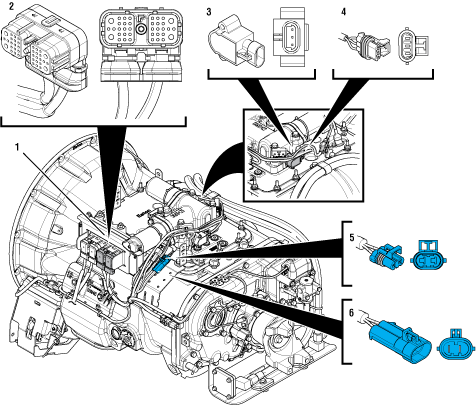 |
1. Transmission Electronic Control Unit (TECU) 2. 38-Way Transmission Harness Connector 3. Gear Position Sensor 4. 3-Way Gear Position Sensor Connector 5. 2-Way Gear Motor Connector (blue) 6. 2-Way Gear Motor Connector Body (blue) |
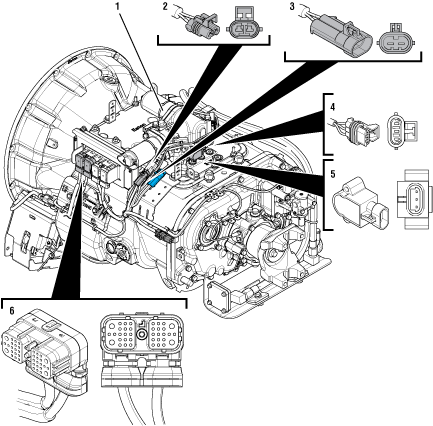 |
1. X-Y Shifter 2. 2-Way Rail Motor Connector (black) 3. 2-Way Rail Motor Connector Body (black) 4. 3-Way Rail Position Sensor Connector 5. Rail Position Sensor 6. 38-Way Vehicle Harness Connector |
Shift Interlock Inspection Procedure
Key off.
NoticeDisconnect both 2-Way X-Y Gear and Rail Position Sensor Connectors.
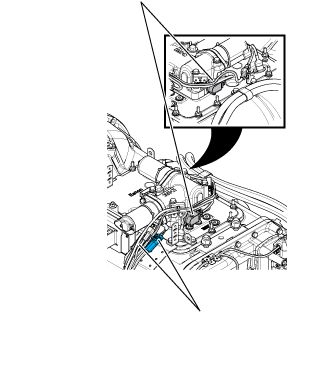
Disconnect both 2-Way X-Y Motor Connectors to the Transmission Harness.
Remove the X-Y Shifter.
Key off.
Inspect condition of the Shift Bar Housing Shift Blocks. Look for uneven gaps between the Shift Blocks or excessive wear to the block faces.
Verify Shift Blocks are tight to the rails and there are no other mechanical issues with the Shift Bar Housing.

Verify transmission shifts fully in to and out of each gear.
Note: If the shift rail will not engage a gear easily, rotate the output shaft until the shift block can engage a gear position.
Return the transmission to neutral position when complete.
If transmission engages a gear, Go to Step D
If transmission will not engage a gear, Go to Step C
Key off.
Drain and save the transmission oil. Inspect oil for significant metal fragments.
Remove 8-bolt PTO cover.
Inspect main case gears for damage or excessive movement.
Inspect Shift Yokes and Sliding Clutches for damage or excessive wear.
If damage is found or there are significant metal fragments in the oil, replace damaged, worn or failed transmission components. Retest operation, Go to Step A
If no damage is found within the transmission main case, refer to Contact Information and contact Eaton for further diagnostics.
Note: If unsure whether damage or wear is significant, take pictures of the transmission gearing. Ensure these pictures are clear and the components are easily visible. Email these pictures to auto.rtw@eaton.com and contact Eaton at (800) 826-4357.
Use a small pry-bar to engage the left-hand shift rail forward until fully engaged into the drive gear.
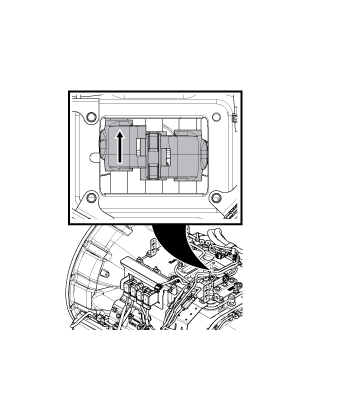
Note: If the shift rail will not engage a gear easily, rotate the output shaft until the shift block can engage a gear position.
With the left-hand shift rail still engaged in a gear, use a small pry-bar and attempt to engage the right-hand shift rail into a gear. You can attempt to move the right-hand rail forward or backward, whichever is easiest.
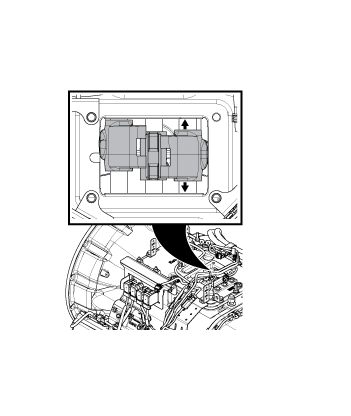
Note: You should expect to see a maximum of 1/8" to 1/4" movement on this rail.
Return the transmission to neutral position.
If the transmission did not engage two gear positions at once, the Shift Bar Housing is working as designed, test complete.
If the transmission engaged two gears at once, repair the Shift Bar Housing. Retest operation, Go to Step A